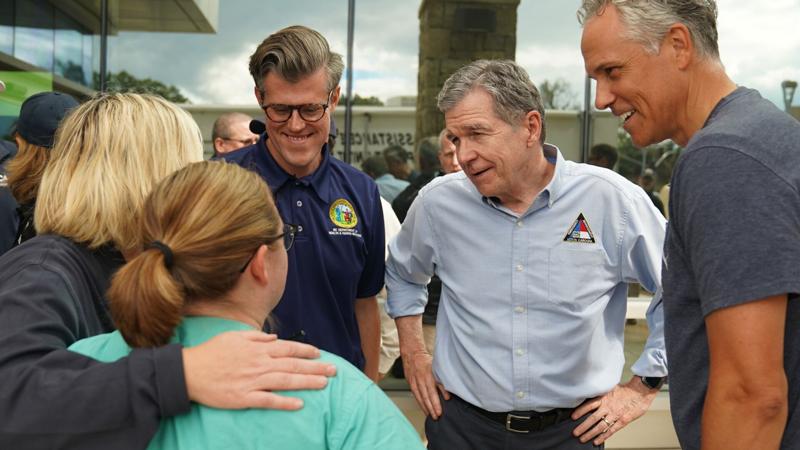In western North Carolina where a fatal flood of historic proportion has torn apart normal, the 2024 election will go on and a razor-thin difference is watched between Democratic Vice President Kamala Harris and Republican former President Donald Trump.
Asheville in Buncombe County is known for a liberal bent, many counties along the Blue Ridge Mountains are red, though it was less than two decades ago Democratic Congressman Heath Shuler carried the area.
Election Day is five weeks away. And the State Board of Elections, as has been done for hurricanes and other unplanned occurrences before, is forging ahead. So, too, will everyone else.
“It would be an ironic shame if the people who most need strong representation in the national and state legislatures play no part in selecting those representatives,” Dallas Woodhouse, North Carolina executive director for American Majority-Action, wrote in an email to The Center Square.
Every effort will be made, the state board said Monday and again Tuesday at a morning presser.
“When disasters strike elections, we use this mantra: ‘We do not stop an election; we figure out how to proceed,’” said Karen Brinson Bell, executive director of the State Board of Elections.
History agrees. Four years ago, it was COVID-19. Primarily in the southeastern part of the state, the 2018 midterms were preceded by Hurricane Florence the first week of September and the 2016 presidential cycle overcame Hurricane Matthew’s landfall on Oct. 8.
Laws, including for state elections, are set by the General Assembly. The state board and its executive director, however, do have emergency powers granted.
“We had emergency powers of the executive director during the pandemic,” Andy Jackson, director of the Civitas Center for Public Integrity, told The Center Square in a telephone interview on Monday. “There was a lot of words back and forth on that.
“With emergency authorization under regulations for the executive director, one of the things you have to consider is how much time does the General Assembly have to act? I’d imagine the General Assembly, after evaluation of what is going on and what is needed, they can go ahead and pass a bill like they did for Florence in ’18. If deadlines come before, the executive director will have authority.”
The Center Square was unsuccessful getting comment from Anderson Clayton, chairwoman of the North Carolina Democratic Party. The party issued a statement of concern for the area, and added, “We take care of our neighbors. We will grieve and rebuild.”
Matt Mercer, spokesman for the state Republican Party, said, “We want the focus for the next few days to be on relief efforts.”
Invariably, debate is coming on how the challenges to even cast votes will impact races. Neither presidential candidate is exceeding the margin of error in polling, making North Carolina a toss-up. Many downballot statewide races have polled close, too.
For context, Trump won the state four years ago by 1.3% (74,483 votes) and eight years ago by 3.6% (173,315 votes). That’s fewer than the 372,000-plus customers out of power at 10 a.m. Tuesday morning.
The state, with winner-take-all 16 electoral college votes, is up to more than 7.6 million registered voters. A 75% turnout rate, as was the case in 2020, would produce more than 5.7 million voters and mean a 4% difference is fewer than 230,000 votes.
“The mountain area of North Carolina is very heavily Republican in most elections,” said Dr. Tom Eamon, associate professor of political science at East Carolina University, wrote in an email to The Center Square. “Exceptions are the city of Asheville and Boone. Too early to predict overall impact.”
Dr. Steven Greene, political science professor at N.C. State, agreed.
“Furthermore, on a partisan basis, yes Asheville is a liberal hub, but a liberal hub within a sea of red,” he wrote in an email to The Center Square. “The 11th Congressional District, in which Asheville sits, is reliably Republican and has been affected throughout by flooding, which suggests that if there is any partisan impact it is more likely to affect Republicans.”
If anything, the region since the turn of the century may well illustrate why the state is called purple – the mix of red Republican and blue Democrat.
“There were counties still voting Democratic in the 20-oughts,” Jackson said. “Heath Shuler won it. In the ’90s and 20-oughts, the 11th District was back and forth. There are some residual Democrats. It’s generally Repbulican-leaning.
“If raw numbers, if both sides are equally motivated, it would be a net loss for Republicans statewide. Considering how close the races are looking, that could be the difference.”
Prognosticators nationwide have seven consensus battleground states. And from them, few if any are acknowledging a pathway to 270 electoral college votes without at least one if not both of North Carolina and Pennsylvania (19 votes).
Seventeen days before early in-person voting is to start, Tuesday morning’s 10 a.m. road closure report had 401 statewide because of Helene. The recovery work is paramount and mourning the lives lost is first.
As Bell said, the election will come and go on schedule.
“As our neighbors, friends and family in western North Carolina, deal with horrific losses of life, property, income and security, it’s important that we make sure these citizens don’t lose their voice in the political process,” Woodhouse said. “We at American Majority-Action are already having conversations with people across the political spectrum on how to guarantee citizens the ability to vote in the flood disaster areas. We don’t know exactly what that looks like, but it will be a monumental effort.
“As far as what side may or may not benefit from the changes in the electorate, we don’t know, and we don’t care. We are all citizens, neighbors and friends. This is so beyond partisan politics. One area American Majority Action will focus on is making sure displaced residents know how and where they can vote once those arrangements are made.”






